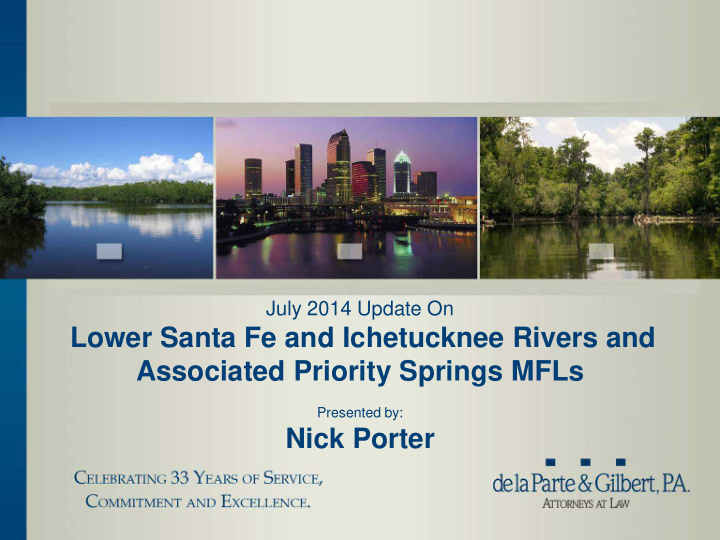



July 2014 Update On Lower Santa Fe and Ichetucknee Rivers and Associated Priority Springs MFLs Presented by: Nick Porter
The MFL Water Bodies • Within Suwanee River Water Management District • Lower Santa Fe River – empties to Suwanee River • Ichetucknee River – Tributary of LSFR • 16 priority springs
MFL Legal Requirements • Sec. 373.042(1), Fla. Stat.: “…the limit at which further withdrawals would be significantly harmful to the water resources or ecology of the area.” •Must be based on “best available information” •Subject to independent peer review • Sec. 373.0421, Fla. Stat: •Agency “shall consider changes and structural alterations to watersheds, surface waters and aquifers..” •Periodic MFL reevaluation and revision • DEP Rule 62-40.473, FAC: •10 water resource values to be considered •Expression of multiple flow/levels defining hydrologic regime
MFL Prevention/Recovery Strategy • Sec. 373.042(2), Fla. Stat.: • Prevention/Recovery Strategy must be implemented if existing flow or level is below applicable MFL or projected to fall below applicable MFL within 20 years • Must achieve recovery to established MFL “as soon as practicable” or prevent existing flow or level from falling below established MFL • Must include phasing or timetable to allow provision of sufficient water supplies for existing and projected water uses, including development of additional water supplies and other measures concurrent with reduction in permitted withdrawals • Implemented as part of regional water supply plan • Can include regulatory and non-regulatory components
2013 Statewide DEP MFLs • Sec. 373.042(4), Fla. Stat.: • Ch. 2013-229, Law of Florida (SB 244) • DEP may adopt MFL or prevention/recovery strategy by rule • Technical and staff support provided by the WMD to DEP for MFL and strategy development • All water management districts must apply MFL and strategy adopted by DEP • No rule adoption by WMD necessary • Important in cases where water uses impact MFLs across WMD boundaries
MFL Significance • Water Supply Planning • Provides planning resource limitations • Indicates need for alternative water supplies • Incorporates prevention/recovery strategy • Water Use Permitting • Establishes level at which “significant” harm occurs • Permitting criteria require compliance with MFLs and/or adopted prevention/recovery strategy • Water Users • Limitation or reduction of traditional water sources • Required development of alternative supplies
LSFR MFLs Development Timeline • 2010 - SRWMD starts MFL development • 2011 - SRWMD, SJRWMD and DEP enter Interagency Agreement • 2011-2014 SRWMD evaluation of water resource values, surface water model development, historic baseline analysis • 2013 - University of Florida Water Institute Peer Review • March 2014 – DEP Notice of Proposed Rule • April 2014 – DEP Rule Adoption Hearing • April 2014 – Admin. challenges to MFL rules by Fla. Wildlife Federation, Ichetucknee Alliance, pro se individual • May/June 2014 – Administrative Final Hearing • September 2014 – Expected ALJ Final Order
Rule Expression of MFLs
Lower Santa Fe River Recovery Strategy • Regulatory Component – Adopted by rule by DEP • Non-Regulatory Strategy – Approved by SRWMD Governing Board
MFL & Strategy Reevaluation Proposed MFL and strategy are an interim step • Phased process • Time to develop improved tools • Time to address remaining concerns and coordinate • Rule 62-42.300(1)(e), FAC: •MFLs will be reevaluated upon completion of North Florida Southeast Georgia (NFSEG) Regional Groundwater Flow Model •MFL and strategy will be readopted no later than December 31, 2019
LSFR Regulatory Recovery Strategy • Applies in North Florida Regional Water Supply Planning Area • Impact evaluation based on “best available” information • New water uses – All impacts to MFL water bodies must be offset • Renewals with increases – Offset effect of increase and limited to 5 year permit • Renewal with no increase - 5 year permit unless MFL impacts offset • Existing permits – Not subject to modification • Proportional impacts – Users only responsible for proportionate share of impact to MFL water body • Georgia impacts – Fla. users not responsible for impact of Georgia use
Administrative Challenge to MFL & Strategy • Challengers – Florida Wildlife Federation, Ichetucknee Alliance, Paul Still • Respondents – DEP and SRWMD • Intervenors in Support – SJRWMD, North Florida Utility Group, Local Counties • Issues Raised by Challengers: •Validity of Statement of Estimated Regulatory Costs •Validity of SRWMD approval of non-regulatory aspects of strategy •Alleged ambiguity in MFL language •Whether recovery strategy is restrictive enough, particularly for existing users •Whether recovery must be achieved •Whether entirety of strategy has to be adopted as rule by DEP •FWF dismissed from case for lack of standing •Final Order from ALJ expected in September
Next Steps: Development of NFSEG Model Existing Groundwater Models NEFSEG Model
Next Steps: Important Considerations • How much do groundwater withdrawals impact flow in the MFL water bodies? • Improve withdrawal estimates • Collection of additional hydrologic and ecological data • How are impacts apportioned? • How will AWS projects be developed and paid for? • What portion of impacts come from Georgia withdrawals? • How will Georgia be incorporated into process? • Further coordination between DEP, SRWMD, SJRWMD, and stakeholders – development of joint regional water supply plan
Recommend
More recommend